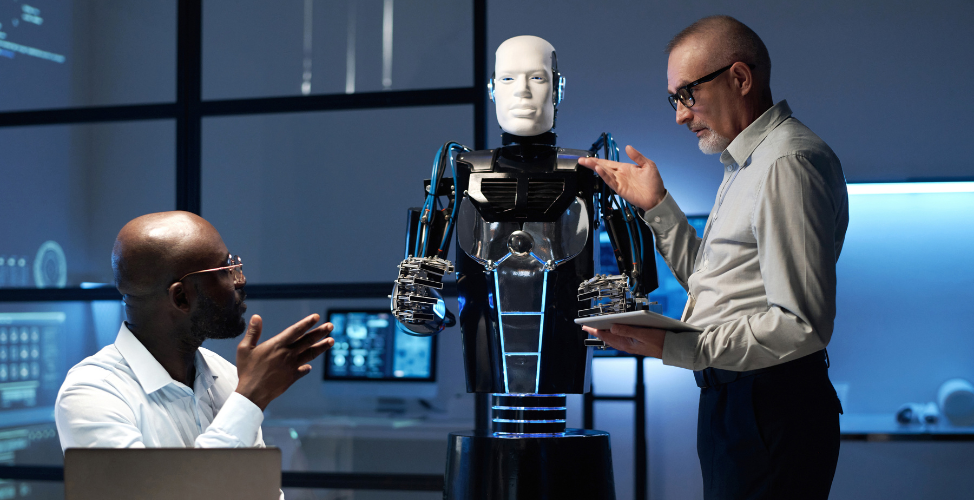Tech’s Perfect Pair: AI And Cybersecurity Take Center Stage In 2024
Everything is being revolutionized by artificial intelligence (AI), and cybersecurity is no different. As the digital environment changes quickly in our hyperconnected world, the combination of AI and cybersecurity is bringing in a new age. AI is at the center of any organization’s cyber planning and plays a crucial part in all technical advancements, with the cybersecurity sector increasing quickly.

A powerful synergy
According to Statista, the market value of artificial intelligence (AI) in cybersecurity is expected to increase from over $10 billion in 2020 to $46.3 billion by 2027, rising at a compound annual growth rate (CAGR) of 25.51%. The corporate sector is depending more and more on AI to secure cyber assets, with 69% of firms finding it important to react to assaults.
AI will undoubtedly play a bigger part in cybersecurity by 2024, offering preventative measures against ever-evolving threats. This year, a few trends that are anticipated to persist and grow according to CGNET as follows:
- Predictive analytics: AI can foresee future cyber threats by examining past data and present patterns. This makes it possible to take preventative action beforehand.
- Behavioral analytics: AI may create baselines of typical user behavior using these insights, and any variations from the norm can be quickly identified as possible security breaches.
- Generative AI: It is anticipated that generative AI, such as ChatGPT and Bing, would influence cybersecurity business strategies and is now undergoing research and development.
- Automated Incident Response: AI technologies are far more rapid and effective than humans at identifying and responding to security problems.
- Adaptive Authentication and Access Controls: 2024 will see the dynamic adjustment of authentication requirements through AI analysis of user behavior. By using automation, security is improved without sacrificing user experience.
- Collaborative Threat Intelligence Sharing: AI will make it easier to analyze and share threat intelligence, promoting a team effort to combat cyber threats.

Furthermore, TrendMicro notes that by enabling accurate and efficient search queries for analysts who aren’t experts in search languages, decoding scripts and instructions, and offering plain-language explanations of alarms, Generative AI may help cybersecurity teams work quicker and be more productive. By instantly implementing security response plans in the event of an incident, it serves as a “force multiplier.”
Additionally, incident reporting burdens may be eliminated with AI-driven automation, which is crucial for regulated businesses. This includes managing ticketing and reporting, translating reports into numerous languages, and quickly extracting actionable information from documents.
A double-edged sword
Cybersecurity and AI integration are not without challenges. The potential for dishonest people to manipulate AI systems is one of the major problems.
According to GlobalData, AI will become more prevalent in cybersecurity, both as a defensive tool and an offensive weapon. As of 2024, bad actors are expected to keep using social engineering techniques to make money. Hackers have discovered that humans are a common weakness that can be readily exploited in all businesses. Cybercriminals will have new tools thanks to advances in AI and analytics to take advantage of human weaknesses.
Additionally, Bain & Company notes that hackers can potentially employ generative AI as a tool, gaining skills akin to those of defenders. It may be used, for instance, by less skilled attackers to produce more convincing emails or realistic-looking deep fake photos, audio, and emails to deliver to phishing targets. Malicious actors can also effortlessly rebuild a known attack code to be slightly different in order to evade detection thanks to generative AI.

Therefore, it is undeniable that AI has many benefits, nonetheless, enormous power also comes with great responsibility. However, generative AI in conjunction with adaptive practices, security-aware corporate cultures, and zero-trust security frameworks also empowers enterprises to mount a formidable and proactive defense.
Businesses must adopt safe solutions and ethical procedures to make sure they take full use of AI’s enormous promise while minimizing the hazards involved. Along with continually monitoring for assaults and routinely upgrading their systems, businesses should also train their staff on appropriate security procedures. Thus, companies may guarantee robust defenses against AI-related risks in 2024 and beyond by arming their enterprises with the necessary security measures.
Discover more about how we can help you to integrate AI and cybersecurity effectively here
New Regulations Expected
According to CGNET, cybersecurity experts feel that it is now crucially vital for regulatory and legal frameworks to intervene and establish standards because of artificial intelligence’s rapid rise in popularity, simple accessibility, and pervasiveness. These rules have already gained popularity, and numerous nations want to produce their own manuals. The new regulatory frameworks should take into account elements like ethics, openness (about the precise workings of certain algorithms), privacy, and uniformity.
Conclusion
In the long term, a more robust security posture results from incorporating AI into cybersecurity. Because AI is always learning and adapting, security systems may change to keep up with the constantly shifting environment of cyber threats. As a result, this combination is more than just a passing trend, it is a revolutionary force that will revolutionize governmental procedures and guarantee more transparency, effectiveness, and resilience. Business leaders, however, need to be careful about how AI alters the threat picture on a regular basis. It’s a must to think of fresh approaches to support their company’s cybersecurity defense plans and concentrate on creating a security shared responsibility model. Contact us to know more!


